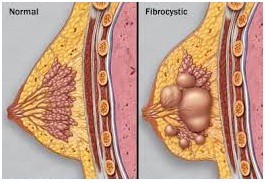Fibrocystic Breast Causes, Symptoms, Diagnosis and Treatment

What Is Fibrocystic Breasts?
Fibrocystic breast is a condition of breast tissue which may affect at least 50% of women of child bearing age.
Also known as fibrocystic breast change, it is marked by pain in the lumps which tends to worsen progressively.
Marked by non-cancerous breast lumps, fibrocystic breast tends to cause discomfort and is related to hormonal influences from the menstrual cycle.
Although it may not be dangerous, it can be bothersome and therefore may require treatment. Also, its presence makes the detection of breast cancer challenging.
Since it does not cause any harm, fibrocystic breast are no longer referred to as a proper disease.
If such breast change is associated with atypical hyperplasia, fibrocystic breasts may lead to occurrence of cancer.
Causes Of Fibrocystic Breast:
The exact cause of fibrocystic breast is yet unknown. However, researchers strongly believe that hormones may play a role.
The suspected contribution of hormones, estrogen specifically, is due to the fact that the condition usually ceases to exist after menopause and is directly linked to menstrual cycle.
It is believed fibrocystic breast is a cumulative process, caused partly by the normal hormonal variation during a woman’s monthly cycle. The most important of these hormones are estrogen, progesterone and prolactin.These hormones directly affect the breast tissues by causing cells to grow and multiply.
Distinct features of fibrocystic breast tissue include:
- Fluid-filled round or oval cysts
- fibrosis
- Overgrowth of cells (hyperplasia) lining the lobules of the breast
- adenosis
Symptoms Of Fibrocystic Breasts:
The following signs and symptoms may be exhibited:
- Breast lumps or areas of thickening that blends into the surrounding breast tissue
- Breast pain or tenderness
- Fluctuating size of breast lumps
- Green or dark brown nipple discharge which may leak without pressure or squeezing
- Changes that occur in both breasts, rather than just one
- Monthly increase in breast pain or lumpiness from mid cycle (ovulation)
Diagnosis Of Fibrocystic Breast:
Fibrocystic breast may be diagnosed via:
- Clinical breast exam.
- Fine-needle aspiration.
- Breast biopsy.
Treatment Of Fibrocystic Breast:
The following treatment options are available:
- Fine-needle aspiration, to drain fluid
- Surgical excision, to remove a persistent cyst-like lumps
- Over-the-counter pain relievers
- acetaminophen (Tylenol, others)
- nonsteroidal anti-inflammatory drugs (NSAIDs)
- Oral contraceptives, which may lower the levels of cycle-related hormones
By : Natural Health News




